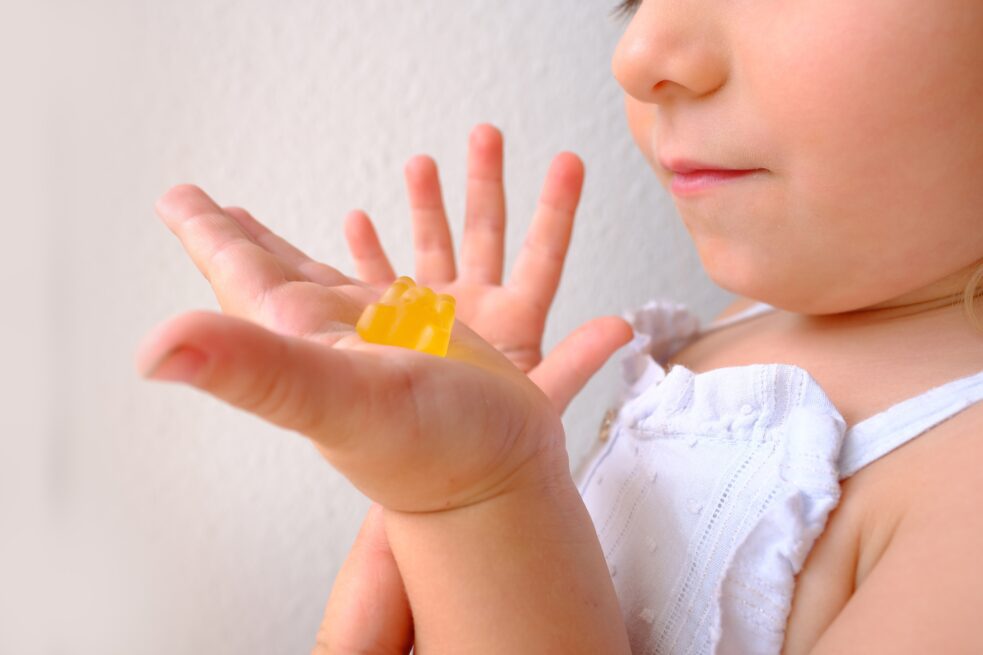In January 2024, a former church daycare director in Cumberland, Indiana, was convicted of neglect and reckless supervision for giving melatonin gummies to more than a dozen children without their parents’ consent. She was arrested after the church’s pastor notified police that she’d doled out the supplements at naptime for several weeks, using a pediatric-strength product intended for children ages four and older — though her wards were four and younger. Parents testified that their kids had trouble sleeping through the night after their midday doses, and experienced side effects including headaches, irritability, and erratic behavior.
The defendant pleaded guilty to all charges and was sentenced to six months in jail.
Apart from the issue of permission, however, her approach to administering melatonin supplements resembles that of millions of well-meaning moms and dads across the country. Although the American Academy of Pediatrics advises that such products should be used under a healthcare professional’s supervision, in conjunction with behavioral sleep interventions, and — with important exceptions — for short stretches, evidence suggests that many parents are just feeding these hormone-laced gummies to their restless kids on a regular basis and hoping for the best.
According to sleep specialists and other experts, that may be an unwise gamble.
The Alarming Rise of Melatonin Use in Children
Melatonin use in children and adolescents has soared in the past few years, perhaps boosted by the sleep-disturbing stresses of the COVID pandemic. (Adult use has grown as well, with U.S. sales totaling $950 million in 2024.) In a 2020 survey, 1.3% of parents nationwide reported giving melatonin to their kids in the past 30 days; by 2023, according to a study published in the Journal of the American Medical Association (JAMA), the figure was 5.6% for preschoolers, 18.5% for school-age kids, and a whopping 19.4% for preteens.
Only 38% of parents in that study said they consulted a doctor before starting their children on melatonin. Nonetheless, many dispensed it as a nightly staple. Preschoolers who took melatonin did so for a reported median duration of 12 months; that time span lengthened to 18 months for school-age kids and 21 months for preteens.
Those statistics worry sleep clinicians and researchers for three main reasons. First, there are the possible risks of taking a potent neurochemical for prolonged periods. Next, there’s concern over the inaccurate labeling and adulterants found in many melatonin supplements. And finally, experts fear that by relying on these products, parents are teaching their kids to depend on medication — instead of safer and more effective approaches — to send them off to dreamland.
“Randomly giving out melatonin without a strategic plan is not a healthy paradigm,” says UCSF Fresno pediatric sleep physician and neuropsychologist Lourdes DelRosso, M.D., Ph.D. “Neither is thinking that we can have a nation of children taking melatonin forever.”
Still, the supplements are so convenient and ubiquitous — sold at nearly every supermarket and drugstore, and widely available online — that even the most conscientious parents may be tempted to try them when their kid starts wailing, “I can’t sleep!”
Before you decide whether to give in, here’s what you need to know.
What to Know About Melatonin and How It Affects Sleep
Although melatonin is commonly described as a “natural” supplement, the stuff found in most brands is a synthetic version of a hormone secreted by the pineal gland in response to darkness. That gland, located deep in the brain, produces 0.1 to 0.9 mg. of melatonin every 24 hours — almost all of it at night. Rising levels of the chemical signal the body that it’s time to sleep, though it takes a complex symphony of biochemical processes to put us under and keep us there.
Melatonin supplements typically start at 0.1 mg. Taken a few hours before a child’s normal bedtime, a low dose can help reset circadian rhythms (as our internal day-night cycles are known), that may have been thrown off by factors such as changes to regular routines. Melatonin also promotes drowsiness, especially at higher doses. Taken close to bedtime, it can ease the transition to sleep — the purpose for which it’s most often used. The effects often fade after two or three hours, however, meaning that users may then wake up, requiring further parental attention. (Although time-release formulas are available, these come in capsules that may be hard for young kids to swallow.)
Like any other medication, melatonin can have short-term side effects. These are typically mild, including headaches, nightmares, bedwetting, mood changes, and dizziness, and they vanish when use is discontinued.
What’s more worrisome about melatonin, however, are the potential long-term effects, along with the effects of other active ingredients often included in the supplements.
Melatonin’s Open Questions: Development, Dosing, and What’s Really in the Bottle
One concern is melatonin’s possible impact on sexual development. The body’s normal melatonin levels decline throughout childhood and adolescence, leading scientists to wonder whether keeping them artificially high could slow the onset of puberty.
Animal research offers some support for this theory, but only four small studies have investigated the effect of long-term melatonin use on puberty in humans. In a small survey of 59 Dutch users, 31% of participants who’d taken melatonin for seven years or more as children reported that they believed their puberty had been delayed to some extent — nearly twice the rate of a control group. In the other studies, participants who’d used the supplement for two to four years reported no such problems.
Much more research will be required to determine the actual degree of risk, if any. “The truth is, we just don’t know,” says Lauren Hartstein, Ph.D., a developmental researcher at the University of Arizona who focuses on sleep and circadian rhythms.
Melatonin plays other roles in the body as well, helping to regulate processes including inflammation, immune function, blood-sugar levels, and cardiovascular health. Researchers are investigating the hormone’s potential for treating patients with a wide range of disorders. However, melatonin supplements have also been associated with dangerous symptoms, such as cardiac arrhythmias in otherwise healthy people. Studies suggest that the risk of such impacts increases at high doses — but the tipping point remains unclear, as does the question of whether long-term use changes the equation.
In fact, no hard-and-fast guidelines for melatonin dosage have been established. Individuals may respond differently to identical quantities, for reasons that remain poorly understood. Doctors usually advise starting with a very low dose and increasing it only if necessary—in part, because taking too much at a time can have the opposite of the desired effect, triggering wakefulness or disrupting circadian rhythms. Yet parents often choose high-dose products for their kids, seeking more bang for their buck, and may keep those gummies coming for years at a time.
Another source of uncertainty around melatonin supplements is how difficult it can be to know what they contain. In the United States, the Food and Drug Administration regulates supplements far more loosely than prescription or over-the-counter drugs. (In Europe, where melatonin is legally considered a pharmaceutical, it is subject to stringent quality controls.) A 2023 study led by Harvard Medical School associate professor Pieter Cohen, M.D., found that melatonin levels in gummies — the form of supplement most often given to children — were incorrectly labeled in 22 out of the 25 brands tested; amounts of the substance ranged from 74% to 347% of those listed on the labels.
A follow-up study in 2024 by FDA scientists found discrepancies of up to 667%, with quantities as high as 50 mg per serving — many times greater than the doses that pediatric sleep doctors typically recommend.
Some melatonin gummies also contain ingredients such as CBD, a cannabis-derived substance that the FDA formally prohibits from supplements (though the ban is spottily enforced). And researchers have detected substances in melatonin supplements not listed on the packaging, including dangerous contaminants such as the neurohormone serotonin. In a 2017 study, that chemical turned up in eight out of 30 brands tested — one of them a chewable tablet, another form of melatonin product often given to kids.
“We need to have a system where these products are regulated more actively,” says Dr. Cohen. “Supplements should go through a process closer to the over-the-counter drug model, where we can be sure of the product’s quality and that what’s listed on the label is what’s in the bottle.”
In the absence of such a process, he and other experts recommend looking online for products certified by the US Pharmacopeia (USP) or NSF, two organizations that test supplements rigorously for purity and accurate labeling. Supplement packages often bear stamps from other purported watchdog groups, Dr. Cohen warns, but such markers can be “confusing and deceptive.” Because there’s no way to know the quality of the programs, he advises regarding them with a skeptical eye.
Finding the Right Approach: Creating a Treatment Plan that Gets to the Root of Childhood Sleep Issues
The question of whether melatonin is appropriate for your child, however, can’t be answered by simply finding a well-vetted product. Instead, it’s a matter of developing a treatment plan that addresses your kid’s particular sleep problem. Melatonin might play a role in such a strategy, but few parents possess the expertise to deploy it in a targeted way.
Which is where healthcare providers come in. Although the FDA hasn’t approved melatonin to treat any condition, clinicians commonly prescribe it for a few evidence-based therapeutic uses.
Preventing Melatonin Overdoses
The proliferation of flavored melatonin gummies and chewable tablets has helped make melatonin the most frequently ingested substance among children reported to national poison control centers. In 2022, a study by the Centers for Disease Control and Prevention (CDC) found that the number of those reports had increased 530% over the preceding decade, totaling more than 260,000 incidents. Most of those ingestions caused only minor symptoms, but 27,000 children were treated at healthcare facilities, 4,000 were hospitalized — and two died.
To prevent such outcomes, the American Academy of Sleep Medicine recommends treating melatonin like any other supplement that can be harmful to kids if taken in excess: Administer it only as directed by a healthcare professional. And keep it out of reach of little hands.
In children with autism spectrum disorder (ASD), for example, the benefits of long-term melatonin use are widely considered clear enough to outweigh concerns about its potential risks. Doctors often recommend melatonin supplements to reduce the severe sleep disturbances associated with ASD. “We know the autistic brain is hyperconnected, which may make kids more prone to overarousal,” explains Beth Malow, M.D., director of Vanderbilt University Medical Center’s sleep disorders division. “Melatonin helps them turn their brain off and relax.” Besides providing more peaceful nights, she adds, it can help prevent the daytime behavioral disruptions that can result from sleep deprivation in children with autism.
Studies also consistently show that melatonin can help kids with attention deficit hyperactivity disorder (ADHD) wind down at night — a process often impeded not only by racing thoughts, but also by stimulant medications.
Angela Gallo, a dancer and choreographer in Columbia, South Carolina, began giving her 14-year-old son melatonin supplements on a pharmacist’s advice, to treat the occasional insomnia triggered by his Adderall regimen. “We tried him on visualizations and yoga breathing, but he was still tossing and turning,” Gallo recalls. “Now, if he wakes up in the middle of the night, instead of getting frustrated and anxious, he knows that he’ll be back to sleep within 15 or 20 minutes.”
For children with sleep troubles who don’t have neurodevelopmental disorders such as ASD or ADHD — or circadian disorders such as delayed sleep phase syndrome, in which a patient’s sleep-wake cycle falls out of sync with the rhythms of day and night — providers’ risk-benefit calculations tend to be different. Melatonin is seldom recommended as a first-line treatment in such cases; instead, physicians try to find the cause of the problem and address it directly.
“When we talk to parents, we look at the whole picture,” says UCSF Fresno’s Dr. DelRosso. “What is the child’s social and physical environment? Are there comorbidities like asthma or eczema that might be keeping them awake? Is there a new baby brother?” She often suggests changes in a child’s bedtime rituals, bedroom light levels, caffeine consumption, or nighttime use of tablets and video games.
Until such interventions have exerted their effects, melatonin may also be prescribed to help the patient get back in the habit of falling asleep quickly. Yet as a tool, melatonin is used as briefly as possible. “As physicians, we want to build an association between sleep and healthy habits.”
Avoiding Dangerous Interactions
Melatonin can interact with various medications and other substances, altering their function or raising the risk of side effects. A partial list includes caffeine (which can increase melatonin levels), the antidepressant fluvoxamine, sedative medications, diabetes drugs, anticoagulants, and immunosuppressants. That’s another reason to check with your doctor before giving your child this popular but widely misused supplement.
Building an association between sleep and melatonin is a big risk parents take when using it for long periods without a doctor’s involvement. Another risk is not addressing the underlying source of a child’s sleep problems, which can include health-threatening pediatric obstructive sleep apnea or even restless legs syndrome, which can occur in about 2% of school-age children.
Not all slumber troubles need to be handled by a physician, of course. But if the problem seems too minor to merit a visit to the clinic, it may be better addressed by applying evidence-based advice on sleep hygiene (habits and behaviors that foster shut-eye), easily found in books or online, than by trying to treat it with melatonin on your own.
That’s the lesson Madeline Miller, a writer in Tampa, learned through personal experience. “When my daughter was five, she decided sleep was optional,” Miller recalls. “No matter what we tried — stories, lullabies, even pretending that we were all going to bed at 7:30 — she’d still be wide awake, chatting about dinosaurs or what clouds taste like.”
She and her husband tried melatonin. That night, their little girl conked out mid-sentence. The couple high-fived, delighted at this elegant solution. A week later, however, the child announced after taking her gummy, “I don’t feel sleepy yet. I think I need two melatonins.”
From then on, Miller and her mate left the supplements in their medicine cabinet. Instead, they doubled down on behavioral techniques, making their daughter’s bedtime rituals more predictable, introducing special calming activities, and banning screens before bed. Although her night-owl tendencies didn’t disappear, getting her settled down became much easier. “Some kids are just wired for late-night philosophizing,” Miller says. “We’ve learned to meet her halfway. It’s a compromise that keeps everyone sane.”






